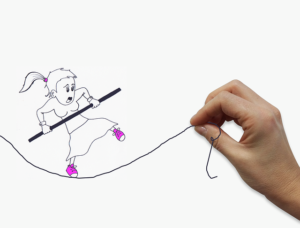Do you want to write a thriller novel that keeps your readers wholly absorbed? If you do, you need to learn how to write good hooks. A good hook will introduce the drama, suspense, and tension that will keep your readers engaged throughout the entire book.
This blog post will discuss how to create hooks that grab readers’ attention right from the beginning of your story and keep them turning pages.
Hooks are essential for thriller novels
A good essay hook draws in the reader and keeps them engaged. There are four main hooks to create drama, tension, surprise, and emotion throughout the book. It would be best to use each kind sparingly to have the maximum impact on the reader’s attention.
The four main types of hooks for thriller novels are:
1. Protagonist in trouble

A turbulent first meeting. An action-packed chase scene. A heart-stopping close call. These are all excellent possibilities for a solid opening for a thriller novel.
Why? Because they help to engage the reader immediately and set up a sense of suspense and anticipation that will keep them hooked throughout the rest of the story.
The best hook for thriller novels is immediately engaging and gets the reader interested in what’s to come. A good hook should be mysterious and compel the reader to want to find out more about the story.
It could introduce the book’s protagonist or antagonist, pose a question that piques the reader’s curiosity, or provide a glimpse into its suspenseful plot. Whichever approach you take, make sure your hook is attention-grabbing and leaves them wanting more!
The protagonist in trouble is the most common type of hook. It involves placing the protagonist in a dangerous or life-threatening situation early on in the story, which creates a sense of urgency and helps to ensure that the reader keeps turning the pages.
Example: In Stephen King’s The Shining, Jack Torrance is already in a precarious mental state when he takes on the job of caretaker at the Overlook Hotel. His mental state immediately sets up the story’s slow, simmering tale that eventually turns into full-on terror.
While this type of hook can be effective, it’s essential to ensure that the protagonist is someone that readers will want to root for. If they’re not, this type of hook can quickly turn into a case of “who cares?”
Another excellent hook for a thriller is Dan Brown’s novel The Da Vinci Code. The book’s first sentence is, “Whenever someone mentions gravity, I always think about Newton sitting under that tree.”
Immediately, readers are drawn in and want to know why Newton is mentioned concerning gravity. This curiosity drives them to keep reading and find out what happens next.
2. Mystery or puzzle to be solved

A good thriller novel is one that not only intrigues readers from the beginning but also includes exciting twists and turns throughout the story.
To grip readers from the start, a good hook for a thriller novel might discuss something suspenseful or mysterious that happens early on in the book.
This can be anything from murder to kidnapping to a crime being committed, which is something that will make readers want to keep reading to find out what happens next.
Additionally, since thriller novels are typically fast-paced, it can be helpful to include a brief overview of the plot in the hook so that readers know what they’re getting themselves into. Ultimately, it’s up to the author to decide what will work best for their particular story.
This type of hook intrigues readers by posing a mystery or puzzle that needs to be solved to move the story forward. One way to create mystery is to include characters with opposing goals or desires.
The mystery or puzzle that needs solving can be something as simple as finding out who the killer is, or it could be a more complicated puzzle that needs to be pieced together to uncover the truth.
Example: In Agatha Christie’s And Then There Were None, ten strangers are invited to stay on an island off the coast of Devon. The story’s hook is that each of the guests has committed a crime, and, one by one, they are being killed off according to a nursery rhyme.
3. Action-packed scenes

One way to grab your reader’s attention from the very beginning is to start with action. This could be as simple as your protagonist being in danger or receiving a threatening message. You’ll immediately capture your reader’s attention and pull them into the story by starting with action.
-For example, imagine that you’re on a train and a group of thugs storm into the car, demanding that everyone hand over their valuables.
-Another way to practice writing hooks for thrillers is to think about the hero’s motivation. What drives them to take on this dangerous mission or fight this evil villain? Is it patriotism? Revenge? A quest for justice? Once you have a clear picture of your story’s stakes and motivations, you can craft an attention-grabbing opening line.
-A turbulent first meeting, an action-packed chase scene, or a heart-stopping close call are all excellent possibilities for a strong opening hook, but not every thriller novel needs to open with such an overtly thrilling scene.
-Sometimes a quiet, suspenseful opener can be just as effective in setting the tone for what’s to come.
-For example, imagine opening the story with a close-up of someone’s face, sweat trickling down their forehead as they lie in bed, heart pounding, trying to control their panic as they realize they’re not alone in the room…
Now that’s a hook!
How to practice writing hooks
-You can start by reading a lot of thrillers. Pay close attention to the first sentence or two of each one, and try to identify the author’s techniques to grab your attention.
-Then, use your personal story or an essay topic to practice using such a hook for your target audience.
-Writing essays can help you write good essay hooks for thrillers. The process of writing an essay can help you develop a clear and concise argument, which is essential for writing an attention-grabbing hook.
-A thesis statement or a research paper can help you generate attention-grabbing hook sentences. For example, if you’re writing a thriller about a group of friends who are terrorized by a madman, you could begin your story with: “The phone call came in the middle of the night. They should never have answered it.”
This short sentence immediately introduces the reader to the fear and suspense that will drive the rest of the story.
-Other ways to hook readers are to surprise them with unexpected plot twists or turns or by subverting expectations.
Examples of subverted expectations
-Start with a bang: If you’re telling a story, begin in the middle of the action instead of at the beginning. This will make your reader sit up and pay attention from the get-go.
-Pull the rug out from under your reader: When your reader thinks they know what’s going on, introduce a new twist that changes everything.
-Go against type: If you’re writing a character, have them do something that goes against what would be expected of someone in their situation. For instance, if they’re meant to be a damsel in distress, have them fight back and save themselves.
-Go against what people think you’ll do based on your appearance: If you’re a punk rocker, show up to your friend’s formal event in a suit and tie instead of ripped jeans and a leather jacket.
4. Cliffhanger endings

Cliffhanger endings create suspense and keep readers hooked until the next installment.
Here are a few possibilities:
-The protagonist is about to be confronted by the person or organization responsible for the crime.
-The protagonist has finally pieced together the clues and is on the verge of exposing the conspiracy.
-The protagonist is in danger and may not make it out alive.
-The antagonist has won, and there’s no hope for retribution or justice.
Conclusion
So, how do you write a hook that will keep readers turning the pages? Start by creating a protagonist in trouble, adding a mystery or puzzle to be solved, and pepper in some action-packed scenes. To practice your skills, try writing hooks for different scenarios. And don’t forget to leave your readers with a cliffhanger ending.
If you follow these tips, you’ll have the edge over the competition—and keep your readers hooked from beginning to end.
If you’re working on your first novel and are looking for more help with your writing, please check out my other articles at https://ullahakanson.com/blog/
Best of luck with your writing!
Ulla

